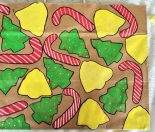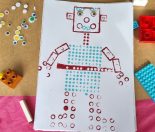Creating your own handmade crafts is a cool way to spend time with your family, and it can also be a fulfilling and therapeutic experience. This simple craft idea combines clay with painting, and is perfect for kids.
If you’re looking for a fun and creative project to take on, making these painted clay frogs could be just what you’re looking for. They have to be made over a few days, to account for the clay drying time, so it’s a great craft to do in the school holidays.
We took the kids to the Otaki Pottery Festival earlier in the year. There they were lucky enough to have a go on the pottery wheel, and also hand building with air dry clay. This is where we learnt how easy it is to make these handmade clay frogs.
At home you can use air dry clay, many forms of modelling clay, a polymer clay such as Fimo that you bake in the oven, or try and source your own handbuilding clay, like what we used.
These charming little creatures make perfect decorations for your child’s bookshelf, and they’re fairly easy to make too. In this article, we’ll take you through the five quick steps to making your own painted clay frogs.
How to Make Painted Clay Frogs
You will need
Air dry clay
A toothpick
A pencil
Resene test pot paints in a range of colours
Resene Polyurethane (optional)
What to do
1: Depending on the size of your frog, you’ll need around 500g (15oz) of clay, or about the size of your fist. Begin by kneading the clay on a hard surface for 3-4 minutes to make it warm and pliable. You may need to help little ones with the initial kneading process.
2: Now begin shaping a bowl shape by pushing your thumbs into the centre and gently pulling up the edges. You can pinch the bowl between your thumb and fingers. And little hands can even use their whole fist or palm to create a bowl shape. Just be careful not to make the edges too thin, or they will crack. Keep going until you have a bowl about the size of your hand with roughly the same width all over.
3: Roll 2 small clumps of clay into balls for the frog’s eyes. Then use the pencil to poke holes in the middle for eyeballs.
4: To attach the eyes to the frog create a ‘slip’ by mixing a small amount of clay with water to make a wet clay paste. Using the toothpick scratch on top of the frog’s head where you want the eyes to sit. Then scratch under the eyeballs where you’ll attach them. Apply your slip to both the head and the eyes, and sit them on top. Now with lots of wet slip on your fingers, gently pull clay from around the bottom of the eyes onto the head until they’re attached.
5: To make the feet, roll 2 more small clumps of clay into balls, press them onto the table to make flat soles, and use the toothpick to make some toes. Now attach them the same way as the eyes. Scratch both surfaces with the toothpick. Apply lots of wet slip. And gently push the clay from the feet up against the frog, until they’re attached. Check that the frog stands up and is balanced. It should sit on the feet and the bottom of the bowl at the same time.
6. Make a long tongue by forming a flat tongue shape. Use the toothpick to make a line down the middle. Extra for experts. You can make a little fly to sit on the tongue. Just make a small ball, with 2 little wings, and poke holes for eyes. Attach the tongue to the frog (and the fly to the tongue) exactly the same as above, using plenty of wet slip.
7: Using the pencil again poke dimples all over the back of the frog to give it a scaly toad like appearance.
8: Now leave to dry in a warm spot out of the sunshine. This process will take at least a day, up to 2 days (if you’re using oven bake clay, just follow the directions to bake off).
9: You’re now ready to start painting. You’ll want a few shades of green or teal. But don’t be afraid to get lots of colours out for your kids to play with. We used about 6 different bright colours to paint ours. Start off by painting the frog completely with a primer or undercoat. This helps to seal the clay to make the colours brighter.
10: Wait for the primer to dry. Now let your kids creativity shine! Try to encourage them to get plenty of paint on the brush, and really brush it on thick, as the clay will continue to soak up the paint. But don’t be too worried about the finish product, they’ll be really proud of them, even if they’re multi-coloured!
11: One last step is optional, once the paint is dry you may like to completely coat in Resene Polyurethane, in a semi-gloss. This will really help the colours to pop. If the clay frogs are destined to go outside in the garden, then sealing them with polyurethane is a good idea, as they’ll last a lot longer.
Making painted clay frogs is a fun and easy way for your kids to express their creativity. And they’ll be really proud to display their frogs in the bedrooms, or out in the garden.
This is a great school holiday activity, so why not give it a try and make your own painted clay frogs today!









